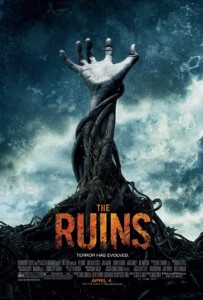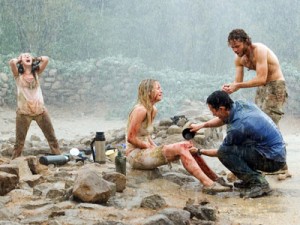 (Originally Posted April 10, 2009)
(Originally Posted April 10, 2009)
I finally caught The Ruins a few weeks ago and didn’t find it particularly scary. I’ve heard the film described as “psychological horror,” but it’s really just a “Monster in the House movie.” The “house” is the titular Mayan ruin hidden in the jungle. The “monster” is a semi-sentient carnivorous vine that can mimic sounds (including a cell phone ringing and human voices) through its bizarre red flowers. The twenty-something tourists who visit the ruin are trapped atop the “house” by a group of angry locals who fear the spread of the vine.
It’s not actuallyas silly as it sounds, but still the film fails to create any suspense or fear (for me, anyway). So, what’s the problem? I don’t think it’s the protagonists, who are actually fairly engaging and even sometimes smart. The primary hero even undergoes a small bit of transformation by the film’s finale. The story structure, presumably borrowed from the novel, is competent. So, that leaves the monster. The film fails because “the Vine” doesn’t seem very monstrous.
I tried to run the Vine through the “What Makes a Monster” rules to diagnose where the film falls apart, and then use that data to suggest some changes that might have made the monster (and the movie) scarier (note that this focuses only on the film and not the novel, which I haven’t read yet).
So, here’s my blueprint for repairing The Ruins:
Focus on the Fear of Infection
The Vine could represent Fear of Mother Nature, Fear of Infection, Fear of Suffocation, or Fear of Insanity. But the most disturbing moments in the film are those that show the Vine crawling beneath a young woman’s skin. We cringe at the thought of anything “alien” getting into our bodies, and when we know something is in there, we just want it out… So we believe that the young woman would endure being cut open so that the bloody foliage can be ripped from her body, and we aren’t surprised when she begins to fear that the Vine is still inside her, perhaps even worming its way into her brain. Unfortunately, these brief moments of terror are totally diluted by sidetracks into the other fears, none of which are very well developed and take screen time away from what could have been a very insidious, skin-crawling movie. Ditching the plant’s (seeming) attempts to drive the tourists insane with its “voice,” and getting the Vine into one of the tourists earlier, having it infect more of them, and increasing the outward effects of the infection would have all made the Vine seem more focused and monstrous.
Increase the Vine’s Body Count
A monster should “threaten, harm or kill” us, but the Vine is actually the least dangerous of the film’s characters: The angry villagers and the tourists themselves do far more damage than the “monster,” who is just waiting for the trapped visitors to get hurt, die of thirst, go crazy and injure themselves and each other, or get themselves shot by the local sentries. The vine is just a scavenger — an opportunistic feeder, wrapping itself around the dead or dying, and somehow consuming them – rather than an active killer. The vine’s most aggressive act is to suffocate one of the character’s by climbing down his throat, but this victim is already at death’s door from a previous accident.
If the Vine is the Monster, it should be responsible for the majority of deaths in the film. Just adding characters probably isn’t the right move — the main characters seem compelling because they each get enough screen time — but the short prologue could have been expanded to show more (already undeveloped) characters fall victim to the monster. At one point in the film, one of the tourists throws a piece of foliage at the locals and hits a young boy, who is then gunned down by his own people when he refuses to quarantine himself on the ruin alongside the Americans. I’d suggest that the boy, fearing certain death, retreats onto the ruin and becomes another potential victim. And maybe he thinks he knows a way to safety, through the ruins…
Deliver on the Promise of the Title
 If a Monster should require heroic measures to escape, defeat, or contain, then the lethargic Vine doesn’t qualify because it’s largely contained to the heart of the ruins. Unfortunately, the tourists spend the bulk of their time on the flat, barren surface of the temple, in broad daylight, where they (and we) can see the Vine coming. If the story had forced the tourists into the cramped, dark interior of the ruins – where the Vine actually lives – the creature would have seemed much more difficult to escape. In effect, this is a “Monster in the House” movie with no house – you never really buy that the heroes are trapped with the monster.
If a Monster should require heroic measures to escape, defeat, or contain, then the lethargic Vine doesn’t qualify because it’s largely contained to the heart of the ruins. Unfortunately, the tourists spend the bulk of their time on the flat, barren surface of the temple, in broad daylight, where they (and we) can see the Vine coming. If the story had forced the tourists into the cramped, dark interior of the ruins – where the Vine actually lives – the creature would have seemed much more difficult to escape. In effect, this is a “Monster in the House” movie with no house – you never really buy that the heroes are trapped with the monster.
Downplay the Villagers
It’s the locals, armed with guns and bows, who keep the tourists trapped on the ruin for most of the movie. By the end of the film, we see them kill more people than the Vine itself. One of the tourists, pointing out that the villagers have salted the earth around the temple, theorizes that they are being quarantined for fear of the “infection” spreading. But, this doesn’t make any sense… If the villagers think that the tourists are infected the moment they step on the temple grounds, why not just kill them all right away? Why allow them to retreat up to the top of the ruin, where they’ll suffer for days and possibly even escape (as one eventually does)? Are they really making some sort of sacrifice to the Vine? I don’t know, because their motives are so unclear. We do know they aren’t totally evil because, at the end of the film, they put one character out of his misery before the Vine can consume him alive, so I don’t buy that they would rather let the tourists suffer atop the ruin for days rather than just kill them all outright. And if they are so afraid of the Vine, why not just torch it, burn it out of the ruin?
Removing or downplaying the role of the villagers would have made the Vine the focus and eliminated some of these questions. The Vine itself could have trapped the heroes atop or, better yet, inside the ruin. If the villagers were truly necessary to force the tourists onto the ruin in the first place, then they should have also been included to make the heroes more desperate. Take potshots, drive them inside the ruin, force them to try to find a way to escape despite the threat of the Vine…
Redesign the Vine
The Vine does not seem uncanny in appearance, nor does its appearance help to sell the primal fear of infection. The bright red flowers are an interesting feature, but when they begin “talking” at the end of the film one can’t help but think this is Audrey II’s distant relative. I would have given the Vine larged, hooked thorns — which nearly everyone can identify. Thorns can be shiver-inducing because they don’t just poke — they grab hold and dig in deeper the more you thrash about. They would hav ealso added to the “infection” theme, breaking the skin and “injecting” themselves and God’s knows what else into the heroes. Alternately (or in addition to), I would have played up the notion that the Vine actually secretes some sort of acid, which allows it to burrow into flesh (I believe this is something established in the novel, but never explored in the film).

Leave a Comment